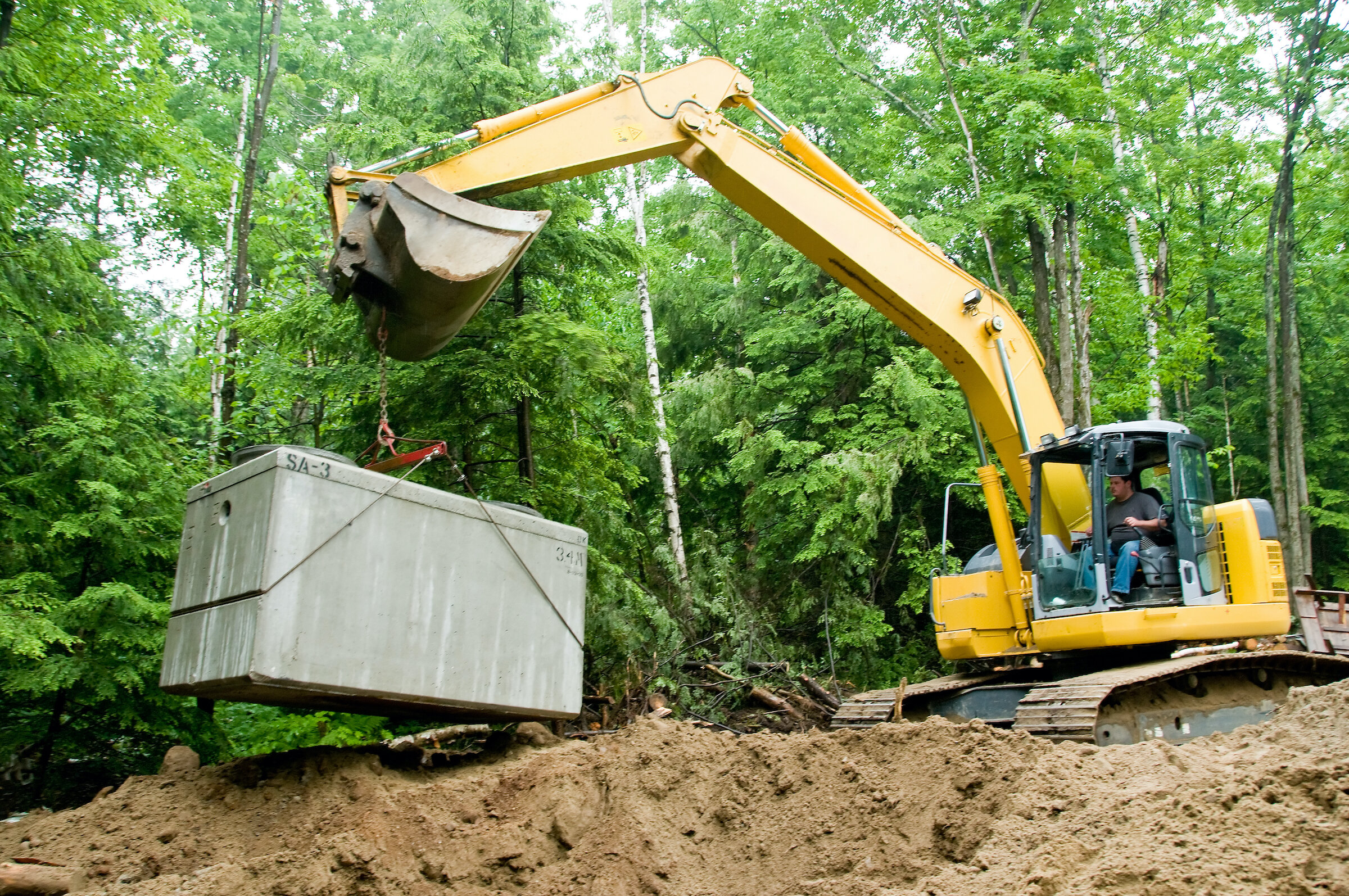The 6 Septic Systems You Must Know
Concrete Septic Tank Installation
Septic Systems
Unfamiliar with the different types of septic systems? If so, you’re not the only one.
If your home isn’t connected to a central sewer system, you likely have a septic system.
A septic system is a connected system of components living under ground that use natural processes to treat wastewater onsite. Typically, a septic system lives in a homeowner’s yard.
Septic systems are most commonly found in rural areas due to the lack of connectivity to a centralized town or city waste treatment facility.
“A septic system is a connected system of components living under ground that use natural processes to treat wastewater onsite.”
Depending on the type of septic system, most require 3 main components:
· Septic tank
· Soil absorption field / drain field / leach field
· Wastewater distribution (piping) system
Why Concrete Septic Tanks May Be Your Best Option
How A Septic System Works
First, the septic system takes in the household’s waste and deposits it into the septic tank. The septic tank then separates and pre-treats the solid waste, and oils from the wastewater.
Most systems then push the liquid wastewater from the septic tank into a distribution network of porous pipes that branch away from the home and septic tank, and slowly release the wastewater into the soil.
Instead of relying on simply releasing the wastewater into the soil, other types of septic systems use pumps, disinfecting product, an evaporation technique, or simply rely on gravity to help funnel the wastewater through sand, or other organic product, before releasing the wastewater into the soil.
The size of the drain field depends on the estimated daily wastewater flow and soil conditions. The number of bedrooms and soil type (arid or saturated) determine the total number of square feet of drain field area that is needed.
Septic Tanks
A septic tank is a waterproof box like structure designed to be buried underground for an extensive period of time.
Septic tanks are designed to be the first stop in the wastewater treatment process. They begin the waste material breakdown process, helping to filter and sort the solid waste, scum and oils from the liquid waste (as known as effluent.)
Heavy solids settle to the bottom of the tank while greases and lighter solids float to the top. The solids stay in the tank while the wastewater is discharged to the drain field for further treatment and dispersal.
There are many different types of septic tanks available. The three most popular types are concrete, plastic (polyethylene), and fiberglass.
Drain Field And Piping System
Septic drain fields (also called leach fields or soil absorption areas) are one part of a household septic system. Drain fields are areas of land, specifically designed to help filter and remove contaminants from wastewater.
A drain field is a thoroughly designed maze of trenches, typically dug several feet deep and layered with gravel and geo-fabric to prevent animal and ground water infestation. Within the trenches also lay perforated pipes used to systematically disperse the household’s wastewater.
A septic drain field, its piping system, and a septic tank make up a conventional septic system.
“Plan to have your septic tank inspected once each year and pumped at least once every 6 months. Without periodic pumping, solid waste matter can clog the pump and harm the drain field. ”
“If you live in a home with septic, it’s best to forgo a garbage disposal. The added solid waste material will require more frequent septic tank pumping, and potentially corrode the drain field, ultimately leading to sewage backups.”
Inside of a septic tank
Popular Septic System Types
Conventional System
Most conventional septic systems are found at single family homes or small business locations. These conventional systems are not typically structured with the ability to serve a larger grouping of people in one location.
A conventional system consists of:
• Septic tank
• An underground wastewater infiltration system or a gravel filled drain field
• Strong geofabric layer that protects the clean drain field from other potential contaminants
Wastewater flows from the structure, out and into the septic tank. Here, the wastewater (or effluent) is piped from the septic tank to the drain field. A sturdy geofabric layer works to protect the gravel layer in the drain field from other potential contaminants.
Once the wastewater filters through the clean drain field, it continues to flow further into the soil and is continually treated by naturally occurring microbes as it slowly trickles its way through the soil layer and toward groundwater.
Benefit: Ease of repair, since most maintenance companies will be most familiar with this system
Drawback: Difficult to install at homes with small lots
Chamber System
Chamber systems have been around since the 1970’s and are a good alternative to the more common gravel field system. Chamber systems are used in areas where the water table is high, alleviating the possibility for poor drainage and messy back-ups.
This system also requires of a series of connected pipes and chambers where the chambers are surrounded by soil.
The septic pipes move the wastewater from the house to the septic tank and then to the chambers. In the chambers, the wastewater drains through the soil. The microbes in the soil treat the wastewater just prior to the wastewater draining away from the housing structure, releasing the treated wastewater into the soil as it travels down toward the groundwater.
Benefit: Installation in areas with high water tables, or significant ground water saturation year round
Drawback: With the added chamber instead of a more traditional drain field, there’s added risk for additional maintenance
Aerobic Treatment System
Aerobic treatment systems infuse oxygen with the wastewater inside the septic treatment tank. The infused oxygen in the wastewater helps to add nutrients to the wastewater and efficiently begin the treatment process.
Aerobic systems offer tanks that both pretreat and final treat, and systems with two separate tanks for pretreatment and final treatment. The ultimate goal is to treat and disinfect efficiently and safely.
Benefit: Good for areas with high water tables or areas that lack the acreage for a proper drain field
Drawback: Much like the drip distribution system, maintenance with an aerobic system is a must.
Drip Distribution System
Utilizing a snaking system of distribution pipes buried near the surface of the soil, the Drip Distribution system does not require a traditional gravel based drain field. With the drip distribution system, piping laterals are buried in shallow ground soil, typically just 6 to 12 inches below the surface.
Without the need for a traditional drain field, this system alleviates the deep digging and provides easier access to piping within the drain field.
Although more convenient, the drip distribution system is more complicated than a conventional system due to the necessary precautions that must be adhered to when dispersing the wastewater into the soil absorption area.
To accommodate this method, a second tank called a dose tank is needed to accept the wastewater after it passes through the septic tank. The dose tank slowly releases the wastewater to the drip system in a timed fashion, so as not to over flow the absorption area. But the dose tank must be hooked-up to electricity to make this happen.
Benefit: Lack of traditional wastewater field system
Drawback: Added expense of electricity, and additional maintenance
Sand Filter System
Sand filter systems allow waste water to flow from the septic tank to a pump chamber, and then from the pump chamber to the sand filtration system.
The sand filtration system is simply a large concrete box filled with a sand. Once the waste water is slowly pumped to the top of the box, it filters through the sand which treats the water prior to its release in the soil absorption area.
Benefit: Good for areas with high water tables
Drawback: Frequent maintenance
Evapotranspiration System
Unlike other septic systems, the Evapotranspiration System’s drain field lives in a closed, waterproof field filled with layers of gravel and sand.
Once the wastewater flows from the septic tank to the waterproof drain field, it slowly evaporates. Unlike the other septic options, the wastewater never filters into the soil.
Installation, maintenance, and ease is high compared to the alternatives. However, evapotranspiration systems are best in warm, dry climates where the wastewater will quickly evaporate.
Benefits: Ease of use high, installation and maintenance are low
Drawbacks: Too much humidity or rainwater will prevent the evapotranspiration system from functioning properly
Mound System
In the mound system, a large sand mound is constructed and used as a drain field.
The wastewater flows in a regulated fashion from the septic tank to a chamber where it is pumped through to the mound. The wastewater flows from the pump chamber through to the mound trench, percolates through the sand, and finally trickles into the soil.
The mound system is a popular option in rural areas, where there is a good deal of land and lack of absorbent soil.
Benefits: Good in areas with shallow soil depth or high/excessive groundwater
Drawbacks: Requires a large amount of space and maintenance
Maintaining Your Septic System
Regardless of which system you have, plan to have your septic tank inspected once each year and pumped at least once every 6 months. Without periodic pumping, solid waste matter can clog the pump and harm the drain field.
Garbage Disposal With Septic
If you live in a home with septic, it’s best to forgo a garbage disposal. The added solid waste material will require more frequent septic tank pumping, and potentially corrode the drain field, ultimately leading to sewage back-ups.
Avoid Flushing Certain Common Household Items
If you live in a house with a septic system, you may need to be more cautious about what you flush down the toilet. Certain common household items, if flushed down a toilet with a septic system, can cause clogging, backups, and possibly damage the system – causing not only inconvenience and headache but a large expense. Be cautious with the following common household items:
• Female sanitary products
• Flushable wipes
• Paper towels
• Tissues
• Bandages
• Coffee grounds
• Diapers
• Cigarettes
Never Flush Chemicals
When using a septic system, never flush chemicals! Chemicals can severely harm and contaminate surface and groundwater, which can lead to illness or even death for animals and people. Take care to dispose of the chemicals listed below at approved hazardous waste depositories:
• Paints, Varnishes, Thinners
• Pesticides
• Oils
• Photography chemicals



